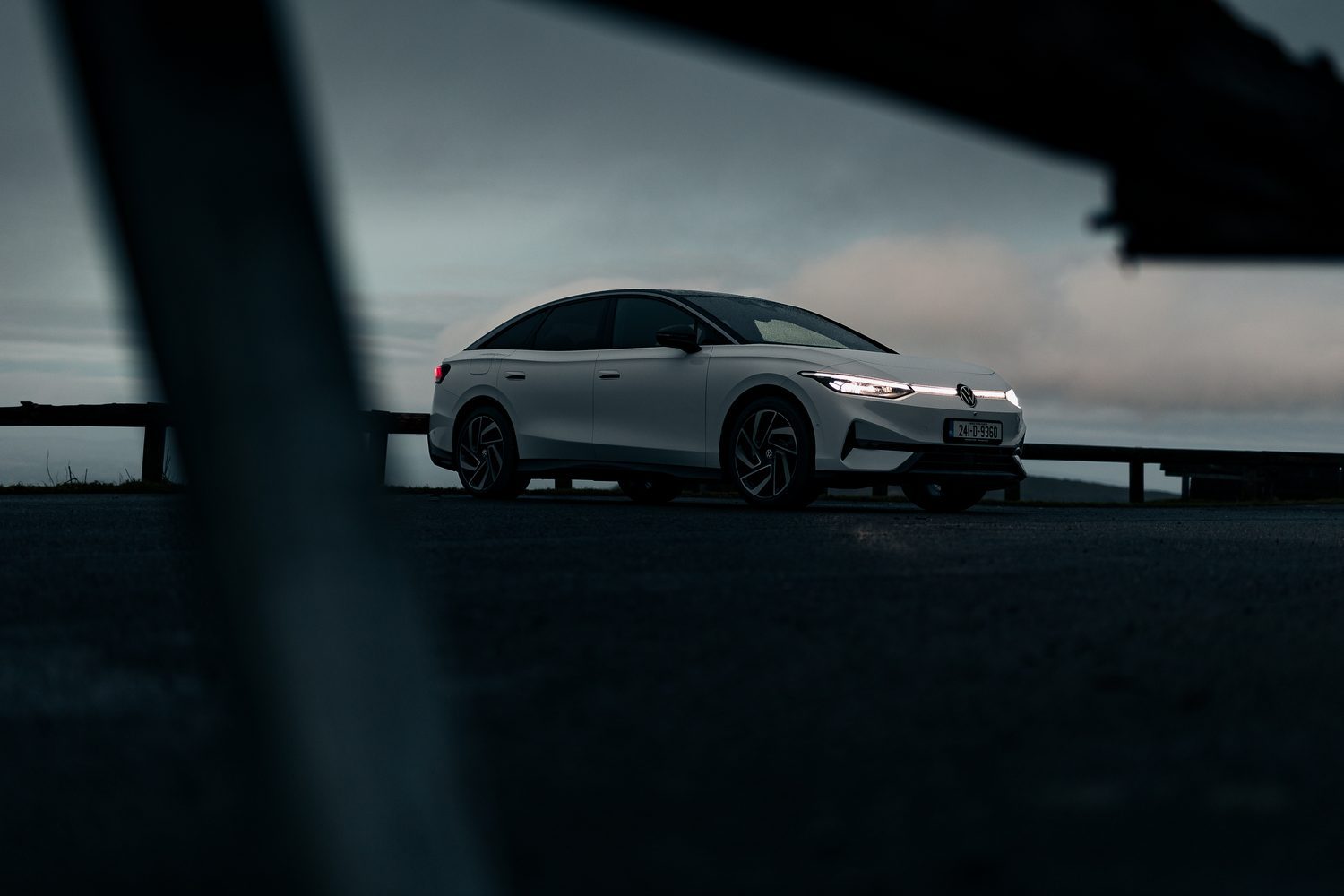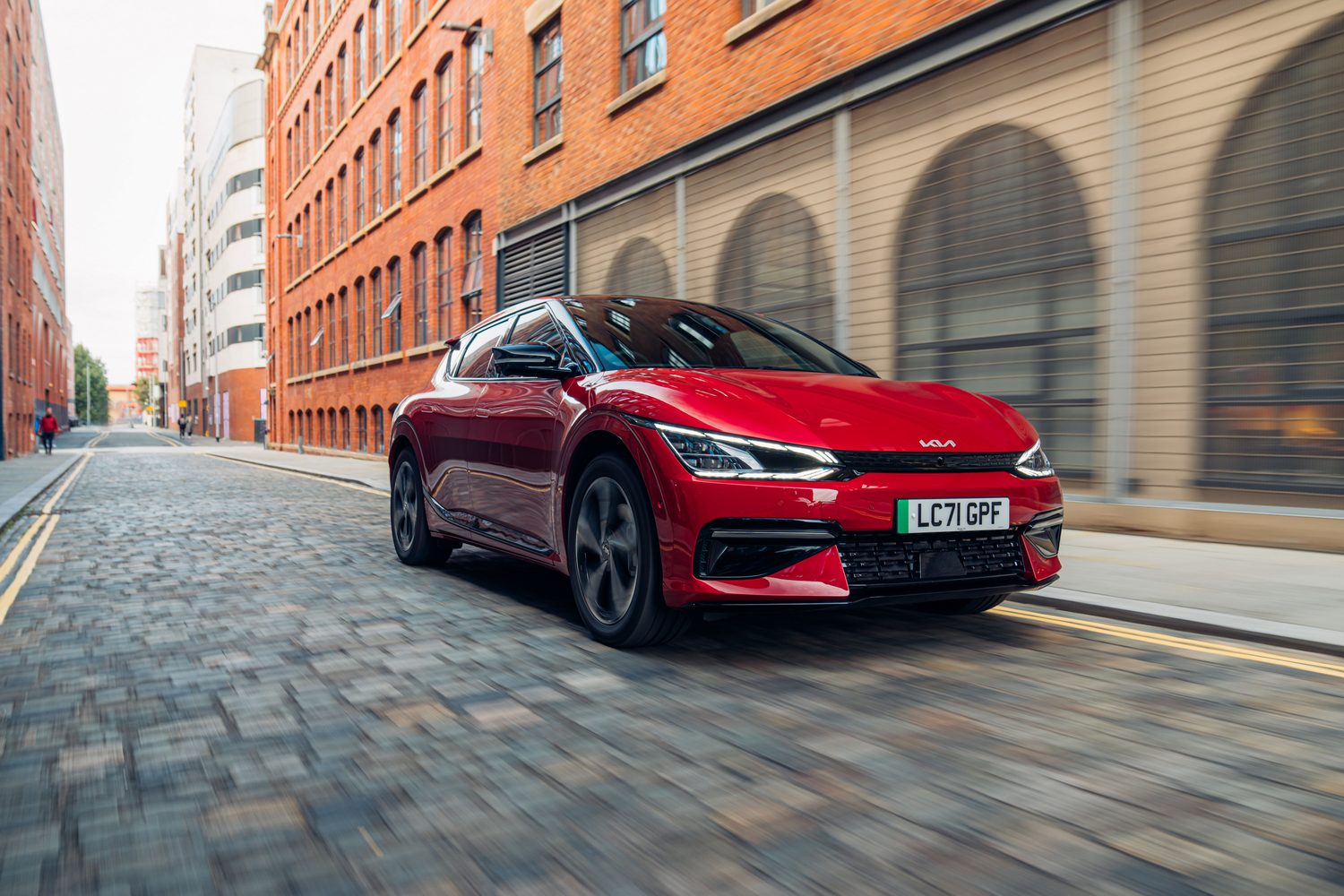Volkswagen ID.7 overview
We can understand why some have assumed the Volkswagen ID.7 is effectively an all-electric replacement for the VW Passat, but a quick look at the measuring tape shows that this is a car far closer in size to the old Phaeton luxury car. It's almost five metres from stem to stern, and 2.1 metres across the mirrors. That and the 2.97-metre wheelbase mark this out as a very big car indeed.

For all its size, it's restrained in its styling. The sweep of the roofline, which closely mimics that of the Volkswagen ID.5 crossover, is distinctive, as is the perforated look of the brake light bar, but the rest is straightforward. There are none of the streamlined flourishes of the Hyundai Ioniq 6 here, for example, but that's not necessarily a bad thing - the Hyundai's design is proving divisive, while it's hard to imagine anyone getting upset by the ID.7's quietly handsome looks.
The Volkswagen ID.7 model range
For now, the ID.7 has a simple model range. In fact, there's just the one model, the Pro Plus with the single rear-mounted electric motor and 77kWh battery pack. Prices start from €56,490 including government grants and rebates (or €59,990 if you're a business customer). Eventually, the range will expand to include a Pro Plus S, which will have an 83kWh battery and an official range of up to 700km, as well as a Touring estate model and a sporty, four-wheel-drive GTX version.
Standard equipment for the ID.7 Pro Plus includes the big new 15-inch touchscreen (more on which in a moment), heated front seats and steering wheel, 19-inch alloy wheels, an augmented reality head-up display, adaptive cruise control, automatic high-beam Matrix LED headlights with dynamic beam control, keyless entry and ignition, 'ArtVelours' microfibre seat trim, massaging front seats, 30-colour ambient lighting, three-zone climate control and an automated parking system that can remember frequently used manoeuvres.

Notably, the ID.7 does not come with an energy-saving heat pump for the climate control - it's a €1,250 option. Our test car was fitted with several options, including the panoramic glass roof, which uses electro-chromic technology to switch from clear to opaque at the touch of a button, 20-inch alloy wheels, and the 'interior style package plus' pack which includes ventilated front seats, heated rear seats, front and rear curtain airbags, a centre airbag and a Harmon Kardon sound system.
Standard safety specification includes 'swerve support' automated braking and steering assistance, pedestrian and cyclist detection, blind-spot monitoring, rear cross-traffic alert, semi-automated lane changing, lane-keeping steering, car-to-X communication, road-sign recognition, predictive speed limiter, and a surround-view camera system. The ID.7 has already received a full five-star safety rating from Euro NCAP, including a 95 per cent adult occupant protection rating, 88 per cent for child occupant protection and 83 per cent for pedestrian protection.
The Volkswagen ID.7 interior
It's fair to call the ID.7's cabin the first 'Gen 2.0' Volkswagen ID interior. That starts with the overall quality, which feels much, much closer to traditional VW levels than, say, the early ID.3s and ID.4s did. The materials used are of a much nicer tactile quality, and everything looks and feels more substantial.

Then there's the touchscreen. We've already experienced VW's new 15-inch screen in the new Tiguan and Passat, but here in the ID.7 it marks a massive leap forward over previous ID-branded screens. This new screen seems far more slick, sensible and simple to use. The overall graphics and style are familiar but look more sharply rendered on a high-definition display. The biggest help of all are the bands at the top and bottom of the screen, which remain in place no matter what menu you're displaying on the centre section. At the top, there are shortcut icons, which you can customise to the ones you use the most, and which massively simplify getting to oft-used functions, while at the bottom the climate control 'buttons' stay on-screen regardless of what else you're doing, which again makes things much easier. As easy as proper physical controls would have been? No, of course not, but such is the way of the motoring world these days.
On the upside, look at the room inside. The ID.7's lengthy wheelbase means that there is simply enormous space for even the tallest people in this car. Space up front is exceptionally good, as is the comfort level of those heated and cooled seats. By moving the drive selector to a column stalk, Volkswagen has been able to open up considerable storage space in the split-level centre console. The storage box under the front seat armrest is deep enough for you to get almost your whole arm in, and there are two cupholders, a wireless phone charging pad and two high-speed 45-watt USB-C outlets (with two more in the back).

Look ahead, and there's an augmented reality head-up display, which is clear and easy to understand, and thankfully works well with polarised sunglasses too.
In the back, the rear seat space is more Phaeton than Passat - stretched Phaeton, even - and the fact that the optional glass roof doesn't need a sunblind means that it robs only one millimetre of rear seat headroom. The backs of the front seats get map pockets down low, and smaller pockets up high for phones and earbud cases. There is a rear seat armrest, too.
The boot, at 532 litres under a the hatchback, is usefully large and square, and there's underfloor storage for charging cables, which makes up for the lack of a 'frunk' in the nose. Of course, if it's true utility you're after, wait for the estate version of the ID.7, which arrives later this year. The back seats split and fold in 60:40 formation, and it's easy to do as you only have to tug a handle within the boot to do it, but they don't fold fully flat, leaving quite a steep upward angle as they approach the back of the front seats. Still, you do get up to 1,586 litres of space with them folded, which is competitive with many SUV models.

One final note is that the ID.7, as with other ID models, can be had with an optional white steering wheel. Avoid this at all costs, as it will just get horribly stained, horribly quickly (at least in our experience). Thankfully, our test car came with black synthetic leather trim for the steering wheel and dashboard.
The Volkswagen ID.7 driving experience
If there's a word that sums up the way the ID.7 drives, it's 'relaxed.' Refinement, aside from a touch too much tyre noise on coarser surfaces, is incredibly good, and the ride quality eases away the worst lumps and bumps without making you feel totally isolated from what's happening underneath. The exceptionally good comfort of the front seats helps, while the forward visibility is helped by the low-set dashboard cowling, even if the big TV-shaped touchscreen does get in the way at times.
It's a very well-behaved car in the corners, and the front McPherson strut and rear multi-link suspension copes admirably with all conditions, but the steering is just a bit too light and detached for my liking, and the body control just a fraction too soft. The ID.7 thankfully avoids the floating feeling that you get from the likes of the Mercedes-Benz EQS, but it's not a car that shrinks around you in corners nor in tight urban confines.

You'll forgive the ID.7 this aspect of its character, though, when you experience its range. Now, the full 625km on a charge of the 77kWh battery (the same unit as found in the ID.4, ID.5, and ID. Buzz) is probably not on the cards unless you drive exceptionally carefully and mostly only around town, but we easily put 500km between charges including 120km/h-on-the-cruise-control motorway work and briskly-driven country roads. This aspect makes long drives a very relaxing prospect.
Even with that motorway mileage, and with the air conditioning going all the time, we averaged 17.1kWh/100km, which is better than we've experienced in some much smaller and less-luxurious EVs. Driven gently on longer runs, the ID.7 matches its official 16kWh/100km consumption, which is impressive for such a big car.
The maximum charging speed, on DC power, is 135kW, which is decent if not exceptional, but it's a shame that Volkswagen doesn't offer 22kW AC charging to make the best use of kerbside chargers.
Performance from the efficient new 'APP550' 286hp electric motor (with its 545Nm of torque) is very impressive, with 100km/h coming up in a brisk 6.5 seconds. The motor doesn't do that tiresome 'instant torque dump' thing either, rather it metes out its grunt in a more measured fashion which feels much more satisfying, disturbs your passengers far less, and ends up making the ID.7 feel more satisfying to drive, overall.
Our verdict on the Volkswagen ID.7

The talking point around the ID.7 is likely to be not its range, and not its roomy cabin, but its lofty price tag. Certainly, it's more expensive than the likes of the Tesla Model 3 or BYD Seal, but then both of those are also considerably smaller and less practical cars. The ID.7's bigness plays against it when the road turns twisty or narrow, but the rest of the time this is an exceptionally refined and well-made car, with superb cabin space and practicality. And both its range and efficiency are hugely impressive, too.
What do the rest of the team think?
My first experience at the wheel of the ID.7 was in the US last year, where it felt compact in comparison to everything else on the road around me. That disguised its size a little, but now having tried it on Irish roads it's clear this is higher up the automotive food chain than the old Passat, and indeed, there aren't many electric cars (i.e. not SUVs) with the same amount of interior space as it on the market here - for any price. Its quality justifies that positioning, and it drives in an assured, understated manner, too. Oh, and as Neil said, it's genuinely efficient.
Shane O' Donoghue - Editor





























